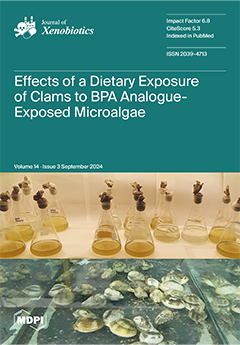Open AccessArticle
Chronic Exposure to Both Electronic and Conventional Cigarettes Alters Ileum and Colon Turnover, Immune Function, and Barrier Integrity in Mice
by
Madjid Djouina, Anaïs Ollivier, Christophe Waxin, Gwenola Kervoaze, Muriel Pichavant, Ségolène Caboche, Djamal Achour, Céline Grare, Delphine Beury, David Hot, Sébastien Anthérieu, Jean-Marc Lo-Guidice, Laurent Dubuquoy, David Launay, Cécile Vignal, Philippe Gosset and Mathilde Body-Malapel
Viewed by 2698
Abstract
Although the effects of cigarette smoke (CS) on the development of several intestinal diseases is well documented, the impact of e-cigarette aerosol (e-cig) on digestive health is largely unknown. To compare the effects of e-cig and CS on mouse ileum and colon, animals
[...] Read more.
Although the effects of cigarette smoke (CS) on the development of several intestinal diseases is well documented, the impact of e-cigarette aerosol (e-cig) on digestive health is largely unknown. To compare the effects of e-cig and CS on mouse ileum and colon, animals were chronically exposed for 6 months by nose-only inhalation to e-cig at 18 or 30 W power, or to 3R4F CS. Results showed that e-cig exposure decreased colon cell proliferation. Several other proliferative defects were observed in response to both e-cig and CS exposure, including up- and down-regulation of cyclin D1 protein levels in the ileum and colon, respectively. E-cig and CS exposure reduced myeloperoxidase activity in the ileum. In the colon, both exposures disrupted gene expression of cytokines and T cell transcription factors. For tight junction genes, ZO-1- and occludin-protein expression levels were reduced in the ileum and colon, respectively, by e-cig and CS exposure. The 16S sequencing of microbiota showed specific mild dysbiosis, according to the type of exposure. Overall, e-cig exposure led to altered proliferation, inflammation, and barrier function in both the ileum and colon, and therefore may be a gut hazard on par with conventional CS.
Full article
►▼
Show Figures






